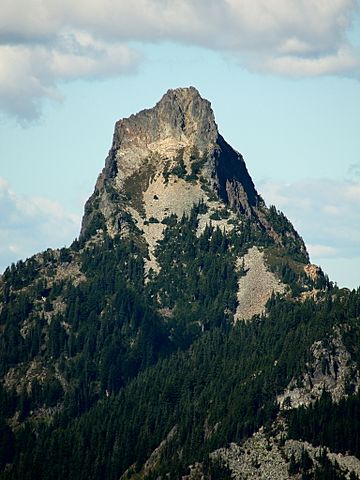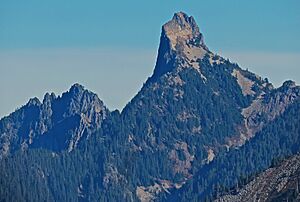Kaleetan Peak facts for kids
Quick facts for kids Kaleetan Peak |
|
|---|---|

Kaleetan Peak seen from Granite Mountain
|
|
| Highest point | |
| Elevation | 6,259 ft (1,908 m) |
| Prominence | 1,859 ft (567 m) |
| Geography | |
| Parent range | Cascade Range |
| Topo map | USGS Snoqualmie Pass |
| Climbing | |
| First ascent | 1914, Sidney V. Bryant |
| Easiest route | Scrambling South Ridge |
Kaleetan Peak is a tall mountain summit in King County, Washington state. It stands about 6,259-foot (1,908-metre) high. This peak is part of the Cascade Range and is located within the Alpine Lakes Wilderness.
Kaleetan Peak is about four miles northwest of Snoqualmie Pass. It sits on land managed by the Mount Baker-Snoqualmie National Forest. The mountain is just west of Melakwa Pass and Chair Peak. It is also north of Melakwa Lake. Rain and melting snow from Kaleetan Peak flow into streams that feed the Snoqualmie River. The closest higher mountain is Snoqualmie Mountain, about 2.89 miles (4.65 km) to the east. The name "Kaleetan" comes from Chinook Jargon, which means "arrow."
Mountain Weather: Climate of Kaleetan Peak
Kaleetan Peak is in a "marine west coast" climate zone. This means it gets a lot of moisture from the Pacific Ocean. Most weather fronts, which bring changes in weather, move from the Pacific Ocean towards the Cascade Range.
When these weather fronts hit the tall Cascade Mountains, they are forced to rise. As the air rises, it cools down and drops its moisture. This process is called Orographic lift. It causes a lot of rain or snowfall on the west side of the Cascades. This is especially true during the winter months.
In winter, the weather is often cloudy. However, during summer, high-pressure systems over the Pacific Ocean bring clear skies. Because of the ocean's influence, the snow here tends to be wet and heavy. This can lead to a high risk of avalanches. The best time to visit or climb Kaleetan Peak is usually from July to September. This is when the weather is most pleasant.
How Mountains Formed: Geology of the Alpine Lakes Wilderness
The Alpine Lakes Wilderness has very rugged land. It features sharp peaks, long ridges, deep valleys carved by glaciers, and granite rock walls. There are also more than 700 mountain lakes scattered around.
Millions of years ago, big geological events shaped this area. These events created the varied landscape and huge changes in elevation across the Cascade Range. These elevation changes also led to different climates and types of plants in various ecoregions. The land here ranges from about 1,000 feet (300 m) in lower areas to over 9,000 feet (2,700 m) on peaks like Mount Stuart.

The Cascade Mountains started forming millions of years ago, during a time called the late Eocene Epoch. This happened because the North American Plate (a huge piece of Earth's crust) was slowly moving over the Pacific Plate. This movement caused many volcanic eruptions and molten rock activity. Also, smaller pieces of Earth's crust, called terranes, joined together to form the North Cascades about 50 million years ago.
Later, during the Pleistocene period (which began over two million years ago), glaciers grew and shrank many times. As they moved, they scraped and shaped the land, leaving behind piles of rock. The last glaciers in the Alpine Lakes area started to melt and retreat about 14,000 years ago. By 10,000 years ago, they had moved north of the Canada–US border. The "U"-shaped valleys you see today were formed by these recent glaciers.
The combination of land being pushed up (uplift) and cracks forming in the Earth's crust (faulting), along with the action of glaciers, created the tall peaks and deep valleys of the Alpine Lakes Wilderness.



